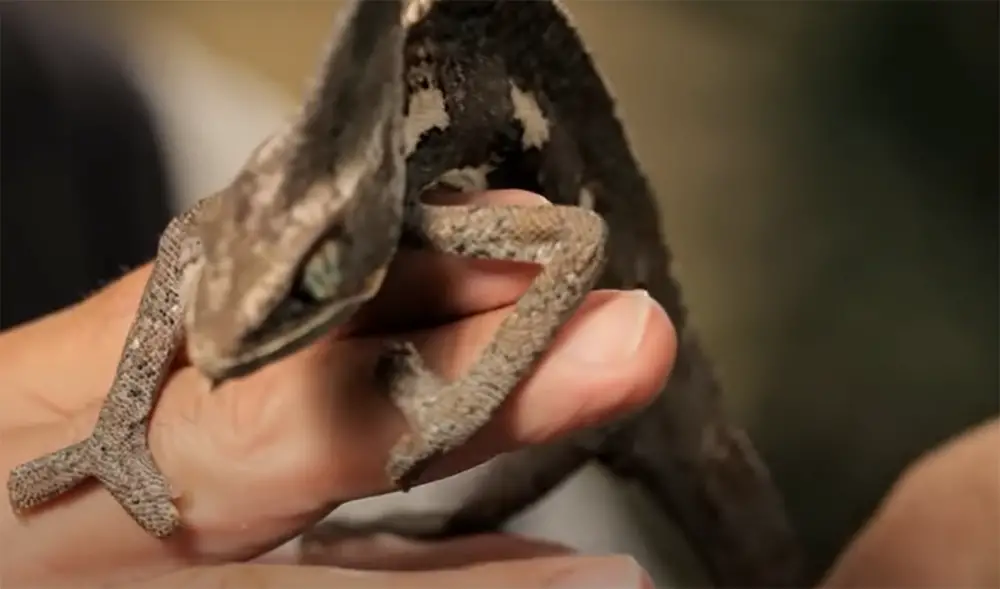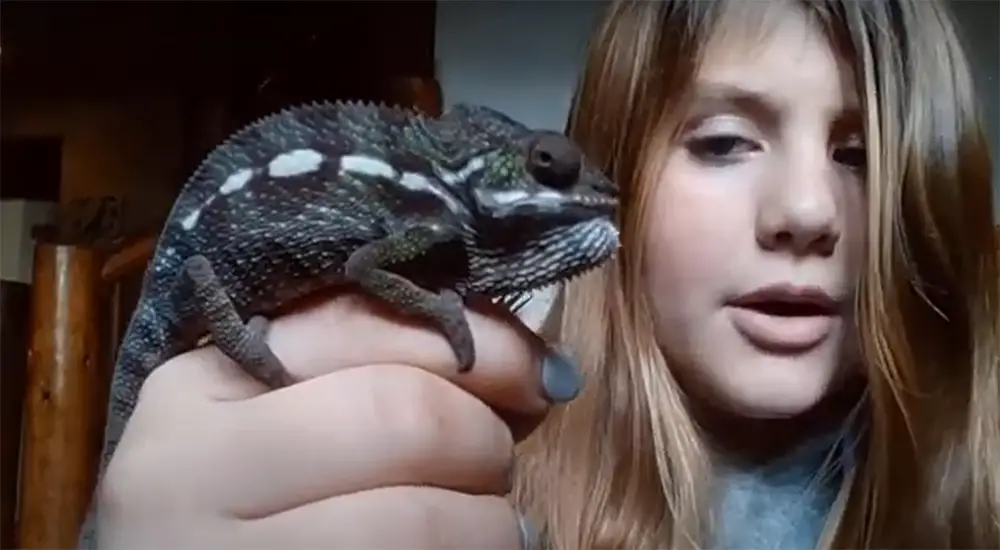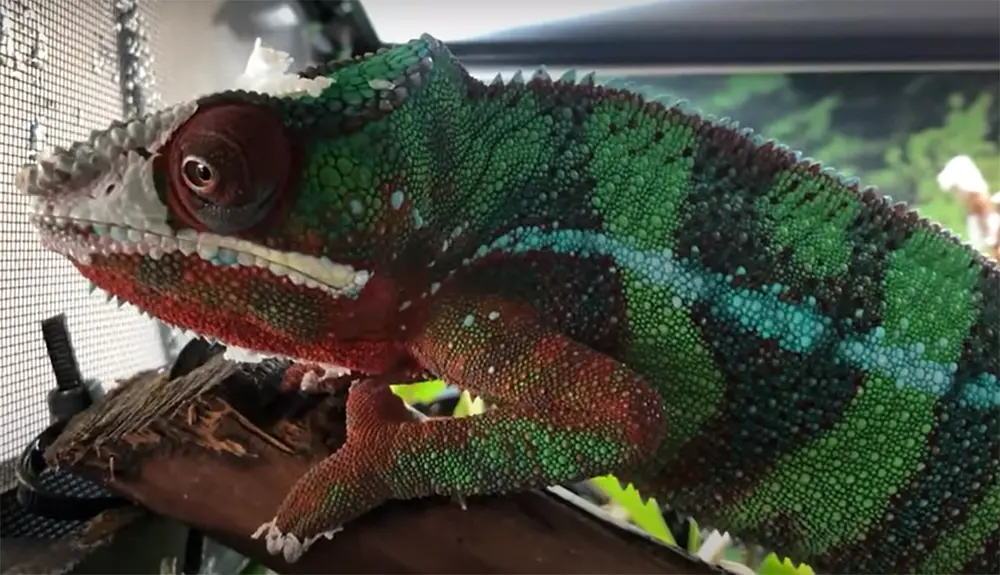A healthy Chameleon is a thing of beauty. The vibrant colors and patterns on their skin make them one of the most popular reptiles in the pet trade. But what happens when your Chameleon turns black? In this guide, we will explore some of the most common reasons why is my Chameleon black and offer solutions to help get your beloved pet back to its former glory.
Black Chameleon due to Stress
Chameleons turn black when they are stressed. When Chameleons are in the wild, they use their color to camouflage themselves from predators. If they feel like they’re in danger, their natural instinct is to change into a color that will help them blend in with their surroundings. [1]

In captivity, stress can be caused by a number of different things.
Other Chameleons in the Vicinity
If you have more than one Chameleon, it’s important to make sure that they each have their own territory. If two Chameleons are kept in too close proximity to one another, it can cause a lot of stress. This is because they are constantly trying to assert their dominance over each other. As a result, they will usually turn black.
Small Enclosure
Lack Of Plants Or Hiding Places
One of the most typical reasons why your Chameleon may be black is because it doesn’t have enough plants or hiding places in its enclosure. Chameleons are naturally shy creatures and prefer to stay hidden away from view. If there aren’t enough places for your Chameleon to hide, it will feel stressed and exposed, causing it to turn black. The solution to this problem is simple: add more plants and hiding places to your Chameleon’s enclosure. This will give your Chameleon the security it needs to feel comfortable and relaxed, and it should start showing its true colors again in no time.
Insects
One reason your Chameleon might be black is that it is trying to attract insects. Insects are a vital part of a Chameleon’s diet and they use their color to help them stand out and attract their prey. If you find that your Chameleon is black more often than usual, try feeding them more insects.

Chameleon Turned Black Because They’re Scared
One of the most frequent reasons for a Chameleon to turn black is due to fear. When Chameleons feel threatened, their natural defense mechanism is to turn black so they can blend in with the darkness and avoid being seen.
If you believe your Chameleon has turned black because they’re scared, there are a few things you can do to help them feel more comfortable and safe. First, try to figure out what is causing them to feel scared or threatened. [2]
Too Many People
If there are too many people or too much activity around your Chameleon, they may feel scared or threatened. Chameleons are very shy creatures and prefer to be in calm, quiet environments.
Chameleons that turn black might be too active. If this is the case, try to create a more relaxed environment for them. This may mean moving them to a different room in your house or keeping visitors away from their cage.
You should also avoid handling your Chameleon too much. Although it’s tempting to hold and cuddle them, Chameleons generally don’t like being handled and it can make them feel stressed.
Other Pet
If you have other pets in the house, they may be causing your Chameleon to feel scared or threatened. Chameleons are very delicate creatures and can easily be injured by other animals.

If you think another pet is causing your Chameleon to feel scared, try to keep them away from each other as much as possible. This may mean keeping your Chameleon in their cage when other pets are around or separating them into different rooms. You should also consider getting rid of any pet that is aggressive or overly playful.
Enclosure By Window
If your Chameleon’s enclosure is near a window, they may be getting too much light. Chameleons need 12-14 hours of darkness to feel comfortable and avoid stress.
Black Chameleon because of being Cold
Mostly your Chameleon is turning black because of cold. Your Chameleon’s natural habitat is warm and humid, so when the temperature drops too low, they will go into what is known as brumation. During this state, your Chameleon will not eat or drink and will sleep a lot. Their metabolism slows down and they will often turn black in color.
If you think your Chameleon has gone into brumation, the best thing to do is to slowly raise the temperature of their enclosure until they are back to their usual selves. You can do this by using a reptile heat lamp or a ceramic heat emitter. Just make sure that you don’t raise the temperature too quickly as this can be dangerous for your Chameleon. [3]
If you’re not sure whether your Chameleon is cold or not, there are a few other signs to look out for. These include lethargy, lack of appetite, and dull colors. If you see any of these signs, then it’s best to raise the temperature of their enclosure until they are warm again.
Once your Chameleon has warmed up, it should start to return to its normal coloration. If they don’t, then there may be another reason why they have turned black which we will cover next.
How To Prevent Your Chameleon Turning Black
The best way to stop your Chameleon from turning black is by providing it with the proper lighting and temperature. If your Chameleon is not getting enough light, it will begin to produce more melanin in order to absorb more heat. This can cause your Chameleon’s skin to turn black. You can prevent this by making sure your Chameleon has access to a basking spot that is between 80-85 degrees Fahrenheit.

Additionally, make sure your Chameleon has access to UVB rays. UVB bulbs help your Chameleon metabolize calcium, which is essential for good bone growth and health. Without enough UVB, your Chameleon may develop metabolic bone disease, which can be fatal.
Another way to prevent your Chameleon from turning black is to provide it with a varied diet. A diet that is high in carotenoids can help prevent your Chameleon’s skin from turning black. Carotenoids are found in dark, leafy greens and orange or yellow fruits and vegetables. Some good examples of foods high in carotenoids are carrots, sweet potatoes, squash, kale, and collard greens. Feeding your Chameleon a variety of colorful fruits and vegetables will not only help prevent its skin from turning black but also help keep it healthy overall. [4]
Black Chameleons are not necessarily unhealthy. However, if your Chameleon’s skin turns black and it starts to have other health problems, then it may be sick and you should take it to the vet. Some common health problems that can cause a Chameleon to turn black include dehydration, metabolic bone disease, and respiratory infections. If your Chameleon is showing any other signs of illness, please take it to the vet as soon as possible.
Lower room traffic
You can prevent your Chameleon from turning black by reducing the amount of traffic in its room. If there are constantly people coming in and out of the room, it can stress your Chameleon out. When a Chameleon is stressed, it can produce more melanin which makes the skin turn black. To reduce the amount of stress in your Chameleon’s life, try to limit the number of people who come into its room. If you have children, make sure they know not to bother the Chameleon and to be gentle when they are around it.
Another way to reduce stress is by providing your Chameleon with hiding spots. Hiding spots will give your Chameleon a place to go if it feels overwhelmed. Chameleons are naturally shy creatures, so it is important to give them a place to feel safe. You can create hiding spots by placing plants or rocks in the enclosure.
Raise the enclosure’s humidity
If the humidity in your Chameleon’s enclosure is too low, it can cause your Chameleon to blacken. This is because low humidity can cause your Chameleon to become dehydrated. When a Chameleon becomes dehydrated, its body will start to produce more melanin in order to absorb more heat. This may cause the skin of your Chameleon to become black. This can be prevented by ensuring that the humidity level in your Chameleon’s enclosure is between 50 and 60 percent.
You can raise the humidity in your Chameleon’s enclosure by misting it with a water bottle two or three times a day. Make sure you are using distilled or filtered water so that your Chameleon does not get sick. You can also add a humidifier to the room where your Chameleon’s enclosure is located. This will help to keep the air around your Chameleon’s enclosure moist and prevent it from turning black.
Plant well
If you have live plants in your Chameleon’s enclosure, make sure they are well-rooted. This is because Chameleons like to climb and if the plants are not well-rooted, they can fall over and injure your Chameleon. Live plants will also help to raise the humidity in your Chameleon’s enclosure. If you do not have live plants, you can use fake ones. Just make sure they are safe for reptiles and that they are securely fastened to the side of the enclosure.
Remove uneaten insects

If you see any insects that your Chameleon has not eaten, remove them from the enclosure. Chameleons can become stressed if they are constantly being bothered by insects. Because stress makes the Chameleon produce more melanin, and blacken it. You can prevent this by removing any uneaten insects from the enclosure as soon as you see them.
Pick your moment
Remember that you need to pick your moment when you are handling your Chameleon. Chameleons are delicate creatures and they can easily become stressed. If you handle them when they are already stressed, it can cause them to turn black. The best time to handle your Chameleon is when it is basking in the sun. This is because basking helps to relax Chameleons and makes them less likely to stress out.
House away from a window
If you are keeping your Chameleon’s enclosure in a room that gets a lot of sunlight, try to move it away from the window. This is because too much sunlight can cause your pet to turn black. Chameleons need 12-14 hours of sunlight each day, so if you are providing them with more than this, it can stress them out. Move the enclosure to a spot in the room that does not get direct sunlight and make sure to provide your Chameleon with a hiding spot so it can get away from the light if it needs to.
Increase the wattage
If you are using a basking light to provide your Chameleon with heat, make sure it is the correct wattage. If the basking light is too weak, it will not be able to provide your Chameleon with enough heat and this can cause it to turn black. The basking light should be between 60-100 watts for a 20-gallon enclosure. If you are using an incandescent bulb, it should be between 100-150 watts. If you are using a ceramic heat emitter, it should be between 50-75 watts.
Reasons Why your Chameleon turns black and drops to the floor?
There are several causes for a Chameleon to become black and fall to the ground. The most common reasons are trying to cool down, stress, or sickness. If you think your Chameleon is overheating, move them to a cooler area and mist them with water. If you think your Chameleon is stressed, try to create a more comfortable environment for them and see if that helps. Unfortunately sometimes when a Chameleon turns black it can be a sign of illness. If your Chameleon is also acting lethargic or has other changes in behavior, it’s advisable to bring him to the vet for examination.
FAQ
Why is my Chameleon almost black?
There are a few reasons that your Chameleon may be darkening in color. If your Chameleon is healthy, it may be trying to cool down or regulate its body temperature. Chameleons can also change color to match their surroundings and blend in for camouflage. If your Chameleon is changing to a darker shade of black, it could be experiencing stress from its environment or diet.
If you’re concerned about your Chameleon’s health, it’s always best to consult with a veterinarian or qualified reptile specialist.
How do I know if my Chameleon is dying?
There are a few things you can look for if you think your Chameleon might be dying. These include:
- Lethargy and inactivity
- Lack of appetite
- Loss of weight
- Dull eyes and sunken appearance
- Skin that is dry and cracked, or shedding excessively
- Open sores or wounds that are not healing properly.
If you notice any of these signs, it’s important to take your Chameleon to the vet as soon as possible. Early intervention can often make a big difference in the outcome. [5]
What happens when Chameleons turn black?
Chameleons that turn black during times of stress are most likely experiencing severe emotional or physical distress. When Chameleons are stressed, they will often change to a darker color as a way of camouflaging themselves. If your Chameleon is black, it’s important to try to reduce its stress levels by providing it with a comfortable habitat and hiding places.
Another reason why your Chameleon may be black is if it is preparing to shed its skin. Chameleons will often turn darker just before shedding as their old skin begins to loosen. If your Chameleon is black and starting to peel, this is most likely the cause. Just make sure that you provide your pet with plenty of humidity during this time to help with the shedding process.
In some rare cases, a Chameleon may blacken due to a medical condition known as melanism. This is when the animal produces too much melanin, resulting in a darkening of the skin. If you think your Chameleon’s black color is caused by melanism, you should bring it to the veterinarian for a check-up.
What do a Chameleon’s Colors Mean?
The most common reasons Chameleons change color are to adjust their body temperature and to communicate with other Chameleons. For example, a male Chameleon will often turn bright colors when he is trying to intimidate or attract a mate, while a female Chameleon will usually stay more muted in coloration. Chameleons can also change color in response to changes in their environment, such as the temperature or the amount of light.
Useful Video: The No.1 Cause of Death of Chameleons in Captivity and How to Avoid It!
Conclusion
If your Chameleon has turned black, it is likely due to one of the reasons discussed above. If you are concerned about your Chameleon’s health, please consult a veterinarian.
With proper care, your Chameleon should return to its normal coloration in no time! Thanks for reading and we hope this article was helpful. As always, feel free to reach out to us with any questions or concerns. We would be happy to help!
References:
- https://www.chameleonschool.com/black-chameleon/
- https://moviecultists.com/why-does-my-veiled-chameleon-turn-black
- https://www.wired.com/2014/04/how-do-chameleons-change-colors/
- https://www.madcham.de/en/supplementation/
- https://www.chameleonforums.com/threads/signs-your-chameleon-is-dying.172138/






Leave a Review